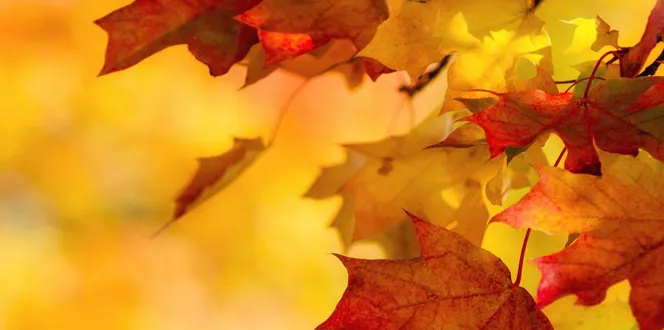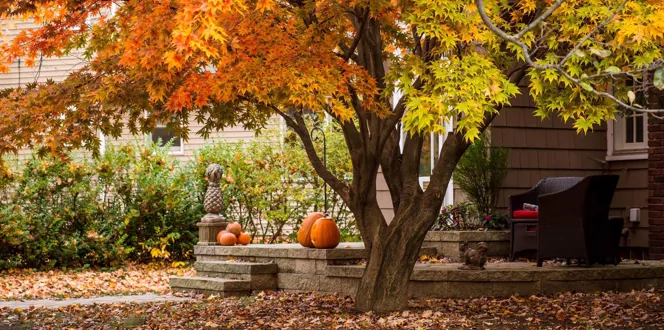Summer draws to a close as warm temperatures give way to cooler weather.
And trees signal the change with some striking foliage transformations from greens to rich rusts, ruby reds, glittering golds, and everything in between.
Autumn may be a sign that winter is near, but it’s not a time to stop thinking about your trees. This is actually a great time to prepare your trees for winter and the following spring. Taking advantage of these cooler days to give your trees some TLC can help protect them during winter and give them an optimum growing environment for the next growing season.
Follow our ultimate fall tree care checklist to ensure your trees are ready to weather any season and continue growing strong.
CLICK HERE TO DOWNLOAD A COPY OF THE FALL SEASONAL CHECKLIST.
Soil Care
When trees grow in the forest, the soil beneath them is rich. This is from the fallen leaves and organic matter that is present on the forest floor providing those trees with nutrients.
In your home landscape, however, this isn’t the case. There are three specific things you can do to enhance the soil and make it more like the forest floor so your trees can flourish.
Fall Fertilization
To ensure trees receive nutrients that were lost, apply a slow-release fertilizer in fall. Slow-release fertilizers mimic nature by slowly and steadily providing nutrients to your tree throughout the following seasons. Having consistent access to nutrients helps trees to grow new leaves, roots and wood as the seasons progress.
Freshen Up the Mulch
High-quality, organic mulch does quite a bit to help your tree thrive.
It helps add organic matter to the soil around the tree, conserve soil moisture, maintain soil temperatures, and gives soil resilience against erosion and compaction.
Organic mulch can be made of ground-up leaves, weed-free straw, or wood chips.
Cover the ground around the base of the tree with 1 to 2 inches of new shredded hardwood and leaf mulch each fall. But don't over mulch the tree or pile the mulch up around the trunk -- something called "volcano" mulching. Keep the mulch 2 to 3 inches away from the trunk or you risk rotting the bark around the trunk.
Make sure to do any fall mulching before the ground freezes. Ideally, mulch over fallen leaves instead of removing them.
Reduce Irrigation
Irrigation systems can keep things green and growing during the hot, dry months of summer, but with the arrival of fall, plants will need less water as the soil naturally stays more moist.
As trees drop their leaves and go dormant, they will need less supplemental water to survive. As the temperatures cool, soils will lose less water to direct evaporation. This means that irrigation should be reduced, or even turned off, to avoid flooding soils.
Flooded soils can result in suffocated roots and the spread of root disease. Reduce irrigation to the point where soils are usually moist and cool to the touch, but never flooded unless from natural rainfall.
Clean Up
The next important fall tree care step is the cleanup phase. You want to deal with leaves and branches in the right way to ensure you’re helping your tree get ready for winter.
Remove Leaf Piles from Beds and Turf
Those autumn leaves are so gorgeous during the season. But, eventually, they do fall.
Raking them up is key to keeping your grass healthy and avoiding snow mold development. To make fallen leaves easier to transport, rake them onto a plastic tarp before moving them.
Add leaf matter from the ground and from gutters, as well as lawn clippings, to a compost bin. Flip the leaf pile every month with a garden fork to aerate it. The bonus: You can use this as mulch or compost to provide trees and shrubs with good organic matter next year.
Tree Trimming
Tree pruning is an essential annual practice. You want to prune dead, diseased, or unsafe branches from your trees not only to protect you, your home, and your belongings, but also to. influence the structure and shape of the tree in the future.
- Trim lifeless branches so they don’t succumb to winter snow and winds.
- Cut cracked, loose, diseased-looking limbs close to the trunk without leaving a stub. Leave wounds exposed to heal.
- If tree branches look too large for you to handle, call a certified arborist for professional, safe help.
Prepare
Winter is coming; it’s inevitable. Preparing your tree for the coming snow, frost, ice, and cold temperatures is a great step to ensure they can get through the season unscathed.
Support Weak Limbs with Cable or Brace
If there are some large, weaker limbs on your trees, they may need a little extra help to survive severe winter weather conditions.
One proactive approach is cabling, or cabling andbracing trees. This technique can support poor or weak branch unions and overextended limbs on your larger, most loved trees. It also reduces strain and stress damage that can result from high winds and heavy ice and snow buildup.
Water Your Evergreens
Fall is the season to give your trees a hearty gulp of water before winter arrives, so they are well-hydrated throughout the freezing winter.
Harsh winter weather can especially cause water loss in the needles of your evergreens while the roots are frozen.
To create an adequate water supply in the soil, your tree needs a good amount of hydration leading up to winter. Water your evergreen tree frequently throughout fall -- enough to keep the soil consistently moist but not saturated. Water regularly until the ground freezes. To efficiently get your tree the right amount of water, weekly deep root watering with slow soaking is the best strategy.
Inspect Trees and Shrubs
While you’re minding your trees, this is always a good time to be on the lookout for pests and diseases so they don’t settle in and get out of control.Always consult a certified arborist who can correctly diagnose issues and prescribe treatments. If you’re seeing conspicuous damage, early fall color, or other signs of stress, these could be signs of a potential underlying problem.
In addition to pruning-out or supporting concerning limbs, fall is a good time to have trees inspected for overall safety. A certified arborist can assess the risk of tree failure at the base or root system. Professional inspection is particularly important if any construction or grading has occurred near a tree.
Tree and Shrub Insect and Disease Damage
Looking for signs of insect and disease damage can be tough to do on your own.
First, you have to identify the tree pest or disease, which can be tough since they can look similar depending on their stage of development. Second, you have to know how to treat that specific pest or disease at the right time for the best control and to avoid wasting time or money.
A local arborist can provide this trained eye to let you know if you have a pest or disease problem, what it is, and how you can best eliminate it.
Potential Tree Safety Hazards
Your trees are assets on your property. But they can quickly move to liabilities if they aren’t well cared for.
Fall is a great time to keep an eye on any potential safety hazards your trees may present. Do you see broken limbs or dead limbs? Does your tree look like it may provide a structural or safety concern?
Some problems just need a quick fix. Just as you wouldn't get rid of a new car if it only had a flat tire, you can easily prune a dead branch and maintain a tree’s safety integrity.
A professionally trained arborist can inspect the tree and share results with you to help you determine an acceptable risk level. You can weigh the tree’s value against its issues and make a decision on next steps that’s comfortable for you.
Mushrooms
As you’re inspecting your trees in fall, you might also pay attention to mushrooms growing on the base of your trees. Often tree owners are the first and only people to see these since they appear for just a matter of days at a time.
Some mushrooms can attack and decay tree roots. As this continues, the tree may become unstable.
Prevention is the best way to combat mushroom or fungus growth on your trees. Follow these tips to keep mushrooms at bay:
- Don’t overwater trees since fungi thrive in moist conditions.
- Protect tree roots from machanical damage (mowers, trimmers, construction etc.) which can lead to disease infections that can kill roots and weaken trees.
- Promote healthy mycorrhizal fungi by maintaining soil organic matter and avoiding soil compaction.
Plant More
Fall is the best time to plant new trees and shrubs. This timing gives them a jumpstart on establishing roots in cool, moist soil over the dormant season before the next growing season.
How to plant a tree properly:
- Pick the right place for planting. Match the tree size and needs to the space. Find a spot that gets the right amount of sunlight and has enough space for the tree’s full-grown canopy, and with adequate soil volume for its roots.
- Before digging, make sure the tree isn’t too close to power lines, underground utility lines, or buildings.
- Dig a hole twice the diameter of, and to a depth of 2 inches less than the full height of the root ball.
- Position the root ball in the hole, making sure the top of the first lateral root remains at one to two inches above round level. Often, soil must be removed from the top of a root ball to expose the first lateral roots. Planting too deep is the No. 1 mistake our Davey arborists see.
- Fill the the space around the root ball with soil so that it is gently graded away from the stem. Amend backfill and the soil from the hole based on soil test results and recommendations for the tree species being planted.
- Properly mulch around the tree to just beyond the dripline.
- Water the new planting adequately. Apply water directly to the soil with a drip or slow soak system. Remember to water deeply, but infrequently. A weekly, deep soak to encourage deep roots is much better than sprinkling plants with a little water every day. It is very important to let water drain out of the soil for several days between waterings. A newly-planted tree will need more water in the beginning to become established in your yard, especially if it is planted during the growing season, so never let the soil dry around it to the point where it becomes hard and dusty.





